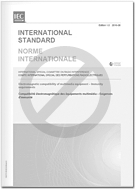
IEC 60352-9:2024
Solderless connections - Part 9: Ultrasonically welded connections - General requirements, test methods and practical guidance
Circulation Date:
2024-02
Edition:
1.0
Language: EN-FR - bilingual english/french
Seitenzahl: 138 VDE Artno.: 252623
IEC 60352-9:2024 provides guidelines for welding and testing of ultrasonically welded connections and includes requirements, tests and practical guidance information.
Ultrasonic welding is a form of cold friction welding that is becoming increasingly popular in many industries. This type of welding uses ultrasonic vibration to join materials together, creating a bond that is both strong and reliable. Ultrasonic welding has been identified as a process in ISO 4063-41 by the International Organization for Standardization (ISO).
The process of ultrasonic welding relies on high frequency ultrasound waves being used to create frictional heat at the connection point. High temperature is not required for this special method of welding, making it one of the most cost-effective ways to join two materials together.
It also requires fewer steps than traditional methods, meaning it can be completed quickly and with minimal resources.
Ultrasonic welding has been around for decades but only recently has become more widely utilized due to advances in technology and its availability at lower cost. It can be used on many different materials including plastics, rubbers, metals, textiles, and composites. Due to its precision and strong bonds it creates, it has become extremely popular in manufacturing processes such as automotive industry, electronics industry, furniture production and even medical device production.
This document covers ultrasonically welded connections made with stranded or flexible wires (class 2, 5 or 6 per IEC 60228) of copper or copper alloy, as well as of aluminium or aluminium alloy. These welded metal-to-metal connections shall employ wires with cross-sectional area of 0,08 mm2 to 160 mm2 and shall not exceed a total cross-sectional area, in case of wire bundle, of 200 mm2. For aluminium or aluminium alloy wires, the minimum required cross-sectional area is 2,5 mm2.
Additionally, information on materials, data from industrial experience and test procedures are included to ensure electrically stable connections under prescribed environmental conditions.
Lastly, this document aims to achieve comparable results when using ultrasonic welding equipment with similar performance and specifications as specified by the termination manufacturer.

